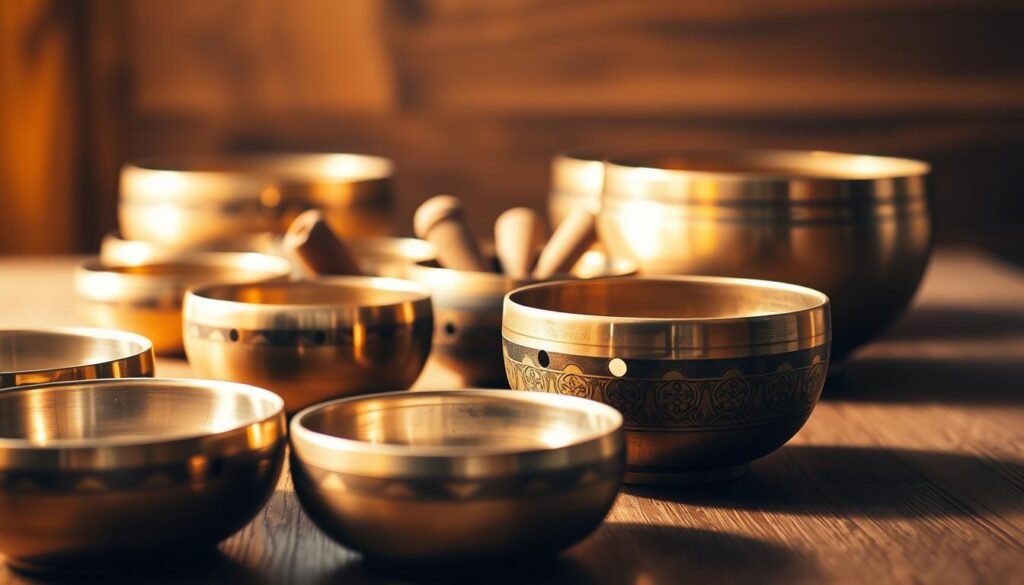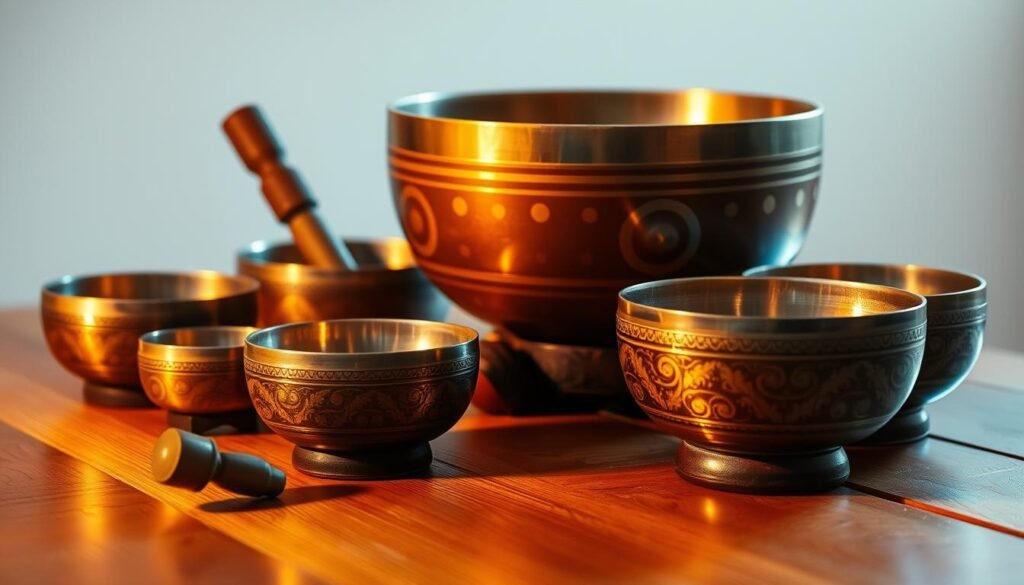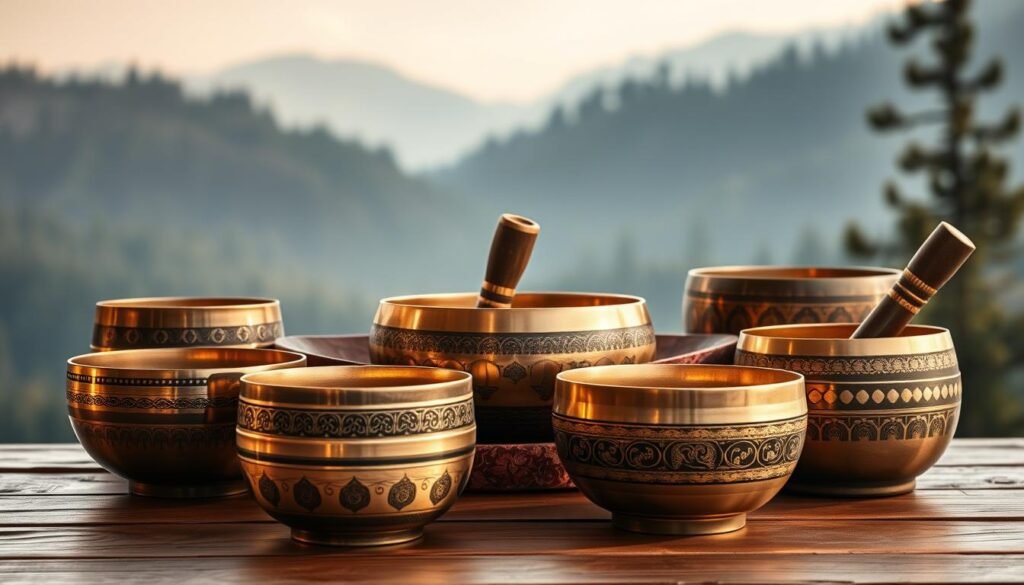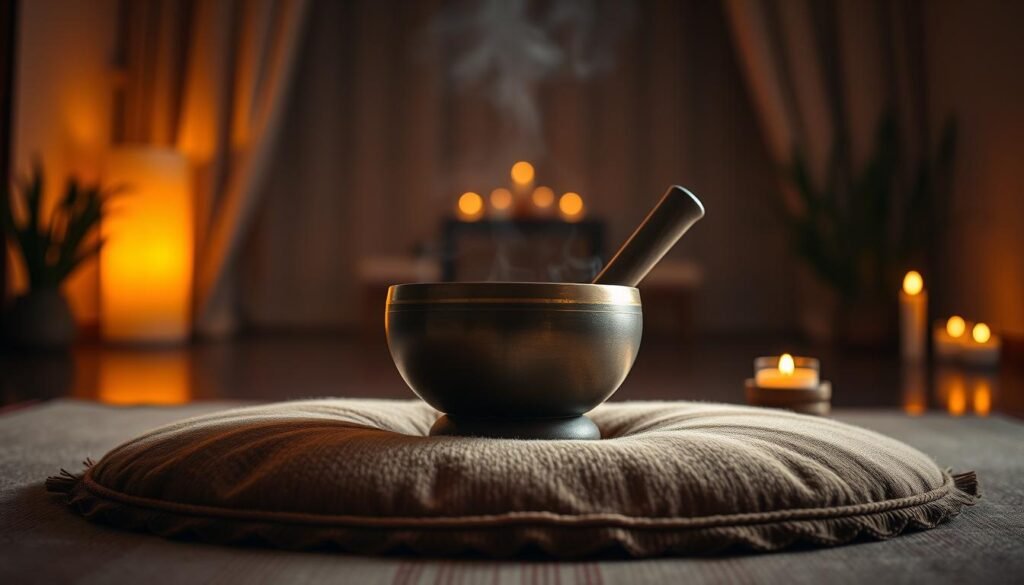
Are you looking for a way to balance your energy and feel better? Tibetan singing bowls have been used for centuries. They are believed to have a deep effect on our energy through their unique sound.
Learning how to use these bowls can help you balance your chakras. This ancient method is based on the idea that the bowls’ sound can align our body’s energy.
Key Takeaways
- Discover the ancient practice of using Tibetan singing bowls for chakra balancing.
- Learn how to effectively use Tibetan singing bowls for meditation and healing.
- Understand the connection between the sound of Tibetan singing bowls and energy alignment.
- Explore the benefits of harmonizing your chakras with Tibetan singing bowls.
- Find out how to incorporate Tibetan singing bowls into your wellness routine.
What Are Chakras and Their Importance?
Chakras are energy centers in our bodies that are key to our health and spiritual balance. They are found along the spine, from the base to the top of the head. Each chakra is linked to different parts of us, affecting our physical, emotional, and spiritual health.
Definition of Chakras
The word “chakra” comes from Sanskrit, meaning “wheel” or “circle.” It describes the energy centers in our bodies. These centers are where life-force energy, or prana, flows. When chakras are balanced, energy flows freely, bringing health and harmony.
Overview of the Seven Main Chakras
There are seven main chakras, each tied to specific colors, sounds, and parts of our consciousness. Here’s a quick look:
| Chakra | Location | Associated Color | Key Themes |
|---|---|---|---|
| Root | Base of the Spine | Red | Grounding, Security |
| Sacral | Lower Abdomen | Orange | Creativity, Emotions |
| Solar Plexus | Upper Abdomen | Yellow | Personal Power, Self-Esteem |
| Heart | Center of the Chest | Green | Love, Compassion |
| Throat | Neck | Blue | Communication, Authenticity |
| Third Eye | Between the Eyebrows | Indigo | Intuition, Insight |
| Crown | Top of the Head | Violet | Spiritual Connection, Enlightenment |
Connection Between Chakras and Well-Being
The state of our chakras affects our overall well-being. Blocked or imbalanced chakras can cause physical, emotional, or spiritual problems. For example, a blocked heart chakra might make it hard to form close relationships or feel emotionally numb.
Using Tibetan singing bowl meditation can help balance the chakras. The bowls’ vibrations can clear blockages and restore energy flow. By adding this practice to your daily routine, you can improve your chakra balancing and connect more deeply with yourself.
What Are Tibetan Singing Bowls?
Tibetan Singing Bowls have been used for healing for generations. They are not just simple instruments. They are tools for energy healing with singing bowls and are key in meditation and spiritual practices.

Historical Background
Tibetan Singing Bowls come from the Himalayan region. They were first used in Buddhist rituals and meditation. Now, they are used worldwide in Tibetan singing bowl therapy sessions.
How They Work
The bowls make sound when a mallet runs around their rim. This sound is believed to heal and relax. The vibrations from the bowls are thought to balance and harmonize the body’s energy.
Types of Tibetan Singing Bowls
There are many types of Tibetan Singing Bowls. Each has its own special features. Some are made from metals, others from materials believed to enhance healing. The choice depends on personal preference and the use in energy healing practices.
- Antique Singing Bowls: Valued for their historical significance and unique tones.
- Handmade Singing Bowls: Crafted by artisans, each bowl is unique.
- Therapeutic Singing Bowls: Designed for sound healing therapies.
The Science Behind Sound Healing
Sound healing explores how different frequencies can affect our energy flow and health. This ancient practice aims to harmonize our body’s energy centers, or chakras. It seeks to bring balance and well-being.
The Impact of Sound on the Body
Sound healing is based on the idea that everything vibrates. Certain sounds can interact with our body’s energy. This can realign and balance our chakras.
Research shows sound can deeply affect our body and mind. For example, the healing vibrations of singing bowls can relax us and reduce stress. This is great for those looking to improve their chakra alignment with sound healing.

Vibrational Frequency and Energy Flow
The idea of vibrational frequency is key to sound healing. Each chakra has a specific frequency. Sound healing, like singing bowls, targets these frequencies to improve energy flow and balance.
| Chakra | Associated Frequency | Sound Healing Benefit |
|---|---|---|
| Root Chakra | 20-30 Hz | Grounding and stability |
| Sacral Chakra | 30-60 Hz | Creativity and emotional balance |
| Solar Plexus Chakra | 60-100 Hz | Confidence and personal power |
Research Supporting Sound Therapy
Modern research is starting to understand sound healing’s effects. Studies show it can reduce anxiety, improve mood, and lower blood pressure.
More research is needed to fully grasp sound healing’s mechanisms. But, the current evidence supports its use as a complementary therapy for well-being.
How to Choose the Right Tibetan Singing Bowl
Finding the right Tibetan singing bowl can greatly improve your chakra cleansing with Tibetan bowls experience. There are many options, so it’s important to know what to look for.
Choosing the perfect bowl is more than just picking one that sounds good. It’s about finding a bowl that matches your energy.
Factors to Consider
Before you start looking, think about these key factors:
- The sound quality and resonance of the bowl
- The material from which the bowl is made
- The size of the bowl and its suitability for your needs
- The aesthetic appeal and craftsmanship of the bowl
Each factor is important for the bowl’s effectiveness in Tibetan singing bowl healing sessions.
Size and Material Options
Tibetan singing bowls vary in size and material, each with its own unique qualities.
| Size | Material | Characteristics |
|---|---|---|
| Small (less than 8 inches) | Metal alloy | High-pitched sound, portable, good for personal use |
| Medium (8-12 inches) | Metal alloy or crystal | Versatile, balanced sound, suitable for most healing practices |
| Large (over 12 inches) | Metal alloy | Deep, resonant sound, often used in group healing sessions |
Choosing the right size and material depends on your personal preference and how you plan to use the bowl.

Testing for the Right Resonance
Testing a Tibetan singing bowl is more than just listening. It’s about feeling its resonance and how it affects you.
To test a bowl, run a mallet around its rim to create a continuous sound. Notice how the sound vibrates within you and if it feels harmonious.
Finding the right Tibetan singing bowl is a personal journey. By considering these factors and testing for resonance, you can choose a bowl that enhances your chakra cleansing with Tibetan bowls and supports effective Tibetan singing bowl healing sessions.
Preparing for Your Chakra Balancing Session
Before starting sound healing, prepare yourself and your space. This will make your experience better and help you get the most from Tibetan singing bowls.
Creating a Comfortable Space
Find a quiet, comfy spot to sit or lie down. Turn off loud noises and add candles or soft lights for a calm feel. Make sure the room is just right in temperature to help you relax.
Being comfortable is important for a sound healing session. You might need a mat or cushion for back support. This setup helps you relax and find inner peace.

Setting Intentions
Setting clear goals is a big step in chakra balancing. Think about what you want to get from your session. Do you want to relax or tackle a specific problem? Knowing your goals helps you focus and makes the sound healing more effective.
Writing down your goals can make them feel more real. It’s not just about the outcome but also the journey of healing and self-discovery.
Meditation Techniques to Use
Meditation can make your chakra balancing better. Try simple things like breathing deeply or using a guided meditation. These can calm your mind and get your body ready for the Tibetan singing bowls’ healing sounds.
- Start with deep, slow breaths to calm your nervous system.
- Use a guided meditation app or video to lead you into a relaxed state.
- Visualize a bright, healing light moving through your body, aligning with the vibrations of the bowls.
Using these meditation tips will help you get the most from sound healing. You’ll find a more balanced state of being.
Techniques for Balancing Chakras
To start balancing your chakras, it’s key to know how to use Tibetan singing bowls. Tibetan singing bowl meditation is a great way to heal with sound, bringing harmony and balance.
The Basic Playing Method
First, learn the basic way to play Tibetan singing bowls. Hold the bowl in your hand or on a cushion. Then, strike or circle the rim with a mallet to make a clear sound. Try different ways to strike to find your favorite sound.
Tips for playing:
- Start with a gentle strike to awaken the bowl’s sound.
- Circular motions around the rim can create a continuous, soothing sound.
- Adjust your pressure and speed to alter the tone and volume.

Using Bowls for Each Chakra
Different chakras need different sounds. Choosing the right bowl for each chakra is key for balancing. Here’s a guide:
- Root Chakra: Use a deep, resonant bowl (around 100-200 Hz) to ground your energy.
- Sacral Chakra: A bowl with a frequency around 200-300 Hz can help stimulate creativity.
- Solar Plexus Chakra: Bowls in the 300-400 Hz range can enhance personal power.
- Heart Chakra: A bowl with a frequency of around 400-500 Hz promotes love and compassion.
- Throat Chakra: Use a bowl in the 500-600 Hz range to support communication.
- Third Eye Chakra: A higher frequency bowl (around 600-700 Hz) can aid intuition.
- Crown Chakra: The highest frequency bowls (above 700 Hz) connect you to the divine.
Combining with Other Healing Techniques
For a more complete healing, mix Tibetan singing bowl meditation with other techniques. Some ideas include:
- Using essential oils to enhance the sensory experience.
- Incorporating guided meditations or visualizations.
- Placing crystals or gemstones on the chakras during the meditation.
By mixing these practices, you can boost the benefits of your chakra balancing session, leading to deeper relaxation and healing.
Step-by-Step Guide to Balancing Chakras
Tibetan singing bowl therapy is a special way to chakra alignment with sound healing. It uses sound vibrations to balance your chakras. This helps improve your overall well-being.
Choosing a Bowl for Each Chakra
To begin, pick a Tibetan singing bowl for each chakra. Choose bowls based on their sound frequency. This frequency should match the chakra’s frequency.
| Chakra | Frequency | Bowl Note |
|---|---|---|
| Root | 20-30 Hz | C |
| Sacral | 30-40 Hz | D |
| Solar Plexus | 40-50 Hz | E |
| Heart | 50-60 Hz | F |
| Throat | 60-70 Hz | G |
| Third Eye | 70-80 Hz | A |
| Crown | 80-100 Hz | B |
Playing Techniques and Duration
After picking your bowls, learn how to play them. Hold the bowl in your hand or on a cushion. Use a mallet to strike it gently, then circle the rim for a continuous sound.
- Start at the Root Chakra and work your way up to the Crown.
- Play each bowl for 3-5 minutes.
- Focus on your breath and the sound’s vibration.

Reflecting on the Experience
After your session, reflect on how you feel. You might feel different emotions or sensations. Writing down your experiences can help you see your progress and understand the therapy’s effects.
By following these steps and using Tibetan singing bowl therapy, you can reach a deeper relaxation. This can also help with chakra alignment with sound healing.
Common Challenges and Solutions
Using Tibetan singing bowls for chakra balancing comes with its own set of challenges. But knowing these can help you tackle them more easily. As you start using singing bowls for chakra cleansing, you might run into a few common problems.
Difficulty Focusing During Sessions
One big challenge is staying focused during sessions. To beat this, make a calm space for relaxation. Try using guided meditations or essential oils to help you stay on track.
| Tip | Description |
|---|---|
| Minimize distractions | Turn off electronic devices and find a quiet space. |
| Use guided meditations | Apps or recordings can help keep you focused. |
| Practice regularly | Consistency can improve your ability to concentrate. |
Managing Emotional Responses
Chakra cleansing with Tibetan bowls can stir up emotions. This is a good sign, as it means the practice is working. To handle these feelings, try deep breathing and let yourself fully process them.
Remember, the goal is not to suppress your feelings but to understand and release them.

Adjusting Bowl Placement
The way you place Tibetan singing bowls affects your session’s success. Try different placements to see what works best for you. Placing bowls near the chakras they match can boost the healing effects.
Key Considerations:
- Start with the bowl near the crown chakra and move down.
- Change the bowl’s spot based on the resonance you feel.
- Try different bowl sizes to get the right vibrational frequency.
By tackling these common challenges, you can improve your chakra balancing practice. This way, you can fully enjoy the healing vibes of Tibetan singing bowls.
Enhancing Your Experience with Accessories
To make your Tibetan singing bowl healing sessions better, try using different accessories. These tools can make your chakra balancing more immersive and effective.
Essential Oils and Their Benefits
Essential oils can really improve your chakra balancing sessions. Some oils match specific chakras, making them more powerful. For example, lavender oil helps with the crown chakra’s calmness. Peppermint oil is great for the throat chakra, boosting clarity and expression.
- Lavender: Promotes relaxation and calmness, ideal for the crown chakra.
- Peppermint: Enhances clarity and expression, suitable for the throat chakra.
- Frankincense: Grounding and protective, often used for the root chakra.

Guided Meditations and Apps
Guided meditations can give your practice structure and support. Apps or recordings help you stay focused and meditate deeper. Many meditations are made to work with Tibetan singing bowls, making them more effective.
| App/Resource | Description | Benefits |
|---|---|---|
| Insight Timer | A free app offering a wide range of guided meditations. | Variety of content, community features. |
| Calm | A popular meditation app with guided sessions. | Soothing narratives, relaxing music. |
| YouTube Guided Meditations | Various channels offering free guided meditations. | Accessible, diverse content. |
Incorporating Crystals
Crystals can boost the healing energy of Tibetan singing bowls. Each crystal is linked to a specific chakra, helping balance. For instance, amethyst is for the crown chakra, and lapis lazuli is for the third eye chakra.
- Amethyst: Promotes spiritual growth and calmness, ideal for the crown chakra.
- Lapis Lazuli: Enhances intuition and insight, suitable for the third eye chakra.
- Rose Quartz: Fosters love and compassion, often used for the heart chakra.
Adding these accessories to your practice can make it more complete and effective. Try different combinations to see what works best for you.
Maintaining Balanced Chakras After Your Session
After trying Tibetan singing bowl meditation and chakra balancing, it’s important to keep the balance. Being consistent is key to keeping your chakras in check. This ensures your well-being stays strong.
Daily Practices for Chakra Health
Simple daily habits can help a lot in keeping your chakras balanced. Regular meditation, deep breathing, and yoga are great. Using Tibetan singing bowls in your meditation can make it even better.
The Role of Diet and Lifestyle
Eating right and living healthy are key for chakra health. Eating foods full of nutrients, drinking plenty of water, and avoiding too much stress are important. Being mindful of your daily habits can also help.
Seeking Professional Help When Needed
If keeping your chakras balanced is hard or if you’re feeling stuck, get help from a pro. Experts in sound healing and energy work can offer tailored advice. They can help you keep your chakras in balance.
